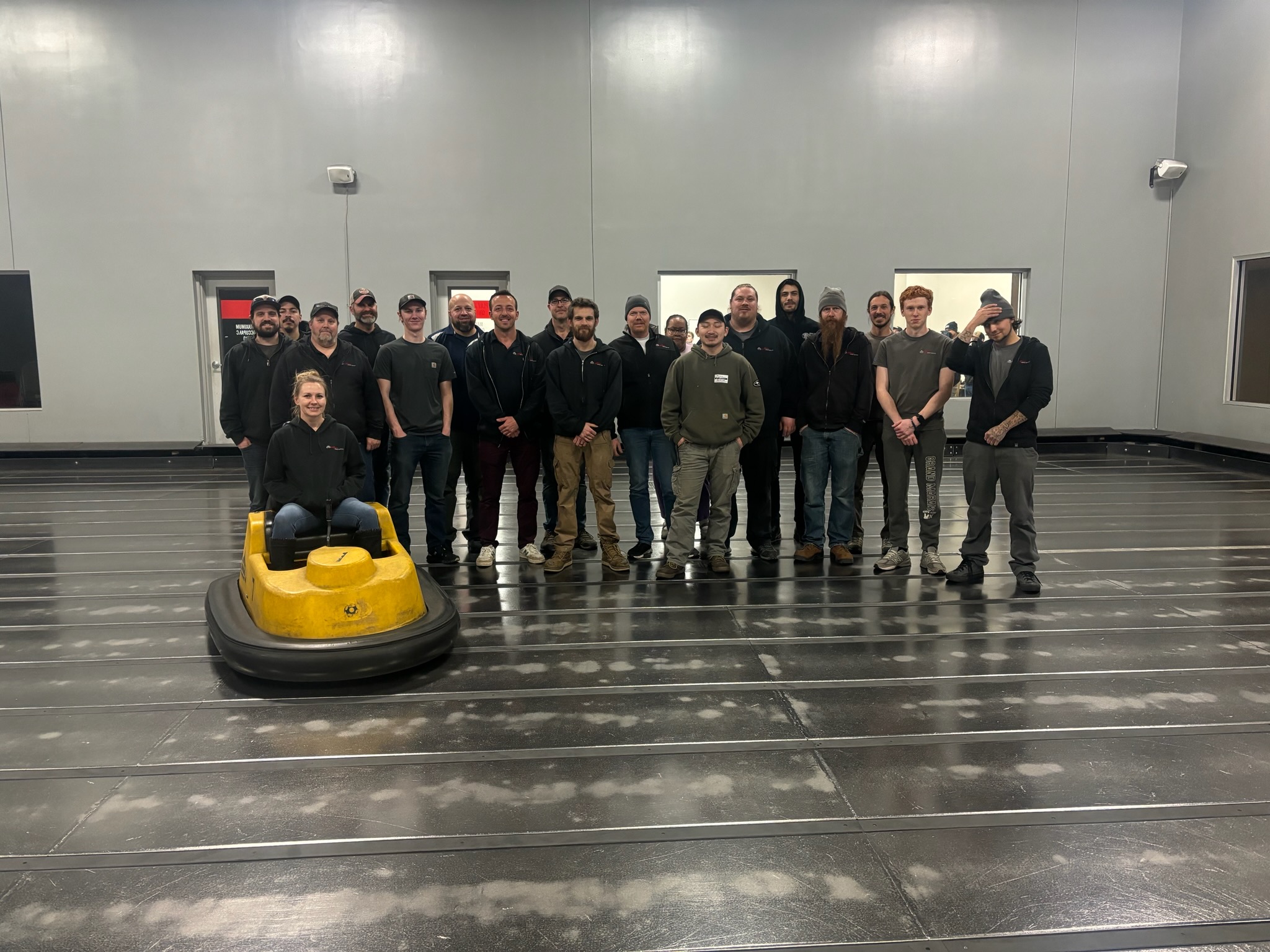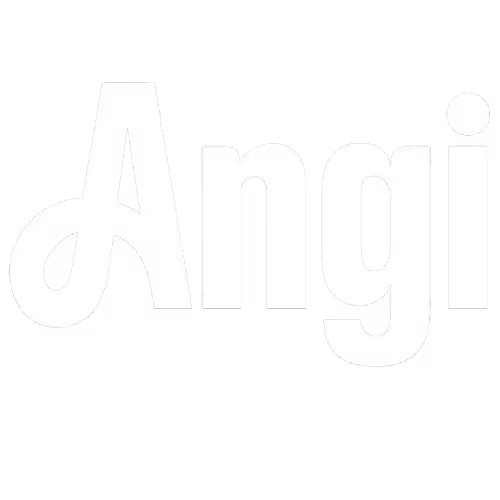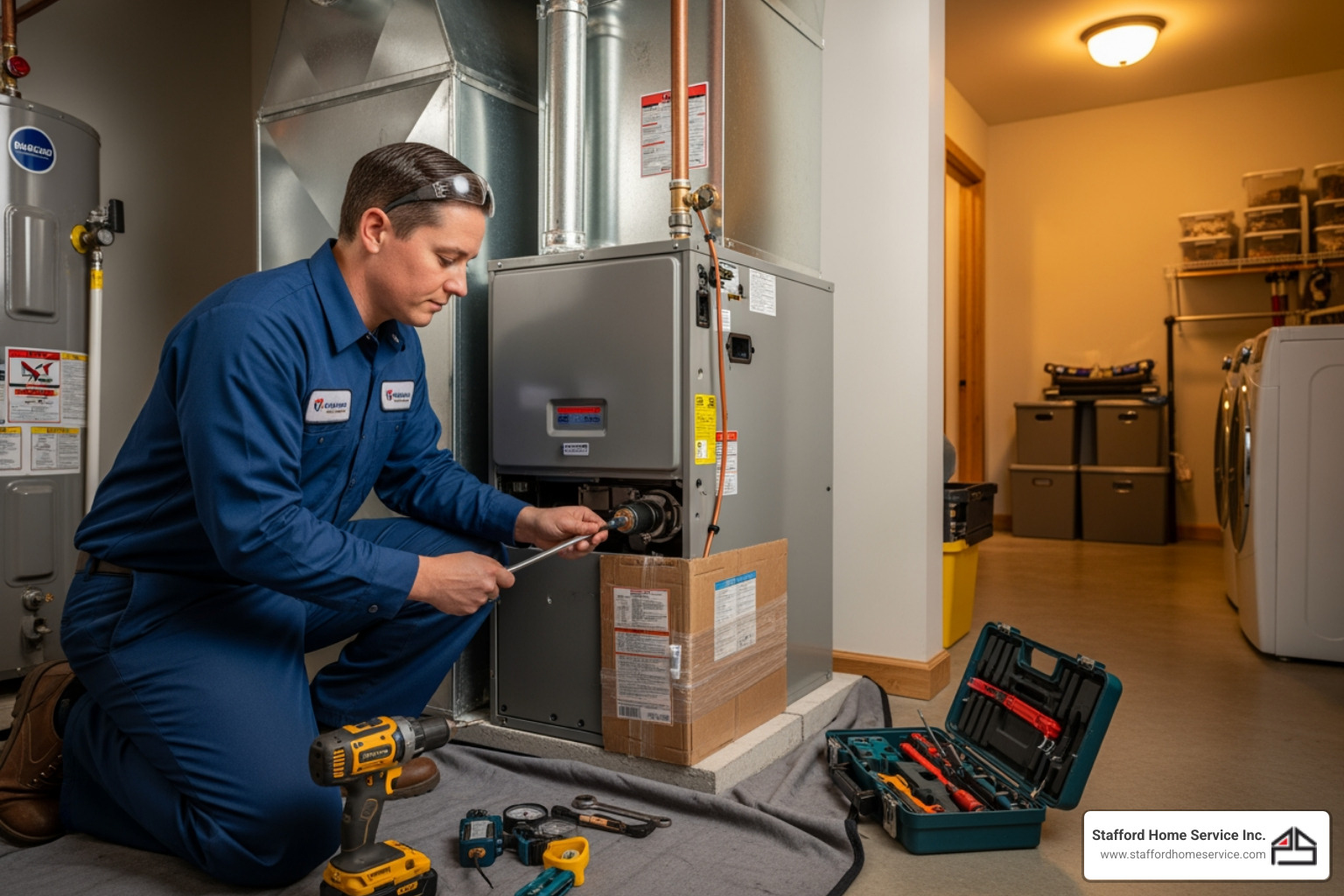Is a Furnace Tune-Up Worth It? Answering Your Top HVAC Questions
Why Homeowners Need Answers to Common HVAC Questions
Furnace repair questions are among the most common concerns homeowners face, especially when winter approaches and reliable heating becomes essential. Whether you’re wondering if that annual tune-up is worth the investment or trying to figure out why your furnace is making strange noises, having clear answers can save you from costly breakdowns and uncomfortable nights.
Most Common Furnace Repair Questions:
- What are the signs my furnace needs repair? – Unusual noises, fluctuating temperatures, increased energy bills, or burning smells
- How often should I schedule maintenance? – Annual professional service, with filter changes every 1-3 months
- Can I fix furnace problems myself? – Basic tasks like filter changes are safe, but gas and electrical issues require professionals
- What does a furnace checkup include? – System inspection, cleaning, safety tests, and component lubrication
- Why is my furnace blowing cold air? – Often caused by thermostat settings, clogged filters, or ignition issues
As one Reddit user noted: “Moved into my first home and scheduled my first HVAC tune up for my gas furnace… I’m wondering if this is worth it or if I should look out for them trying to sell me unnecessary things.” This concern reflects what many homeowners experience – uncertainty about when professional service is truly needed versus when they’re being oversold.
Research shows that heating-related energy usage can account for up to 42 percent of your home’s utility bill costs. A furnace will typically work reliably for 10 to 15 years, but proper maintenance and timely repairs can extend that lifespan significantly while keeping your energy costs manageable.
Understanding the basics of furnace operation and common issues helps you make informed decisions about maintenance, repairs, and when to call professionals. The key is knowing what’s normal, what’s concerning, and what actions you can take to keep your heating system running efficiently.

Simple guide to Furnace repair questions terms:
- Furnace heat exchanger
- Furnace won’t turn on
Recognizing Signs of Furnace Trouble
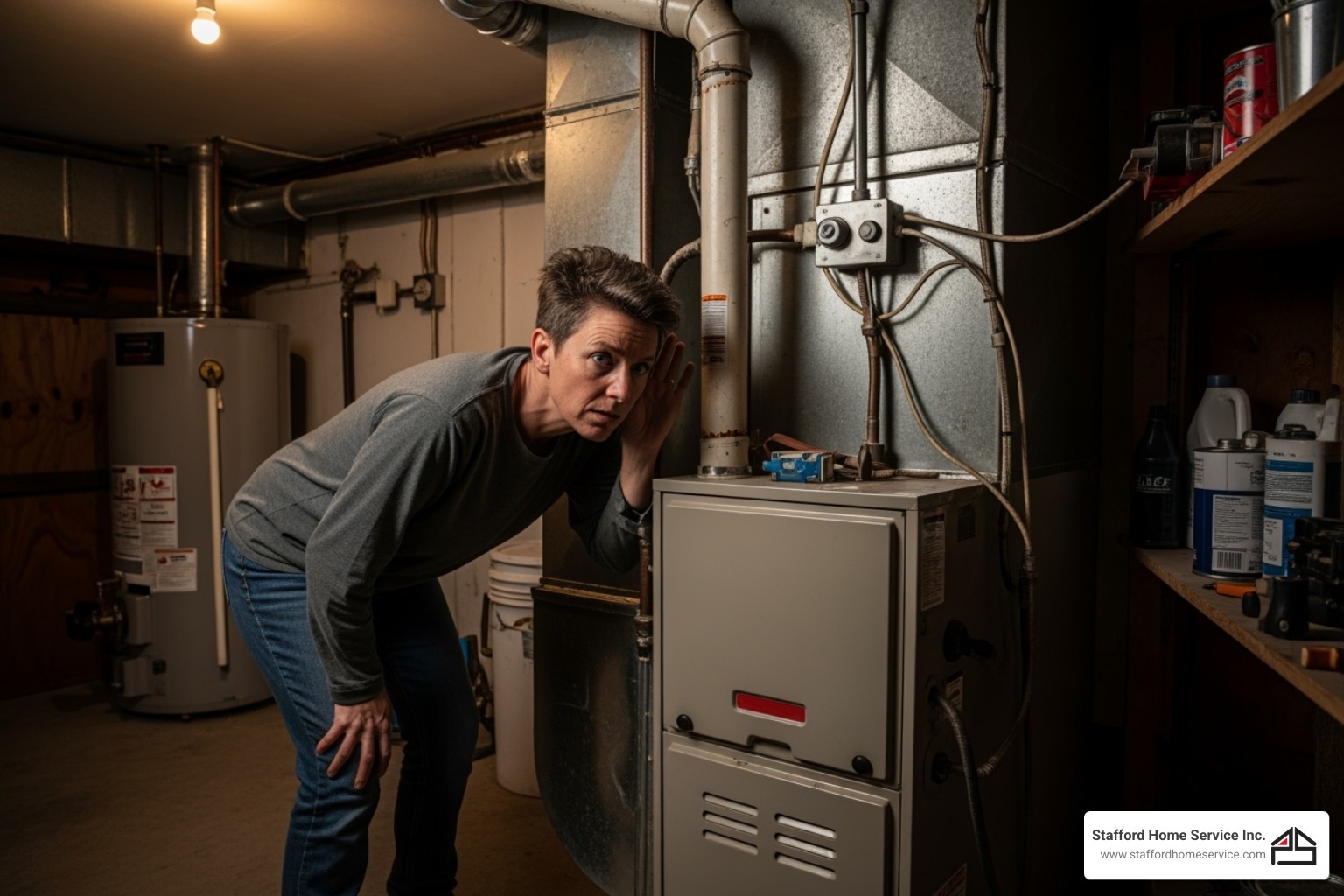
Your furnace has its own way of crying for help – you just need to know what to listen for. Think of it like your car making that weird noise you’ve been ignoring for weeks, except this time it’s the system keeping your family warm and comfortable.
Most homeowners ask us the same furnace repair questions when something seems off. The good news? Your heating system usually gives you plenty of warning before it completely gives up on you.
What are the common signs that my furnace needs repair?
Strange noises are often the first red flag. Your furnace shouldn’t sound like it’s hosting a percussion concert in your basement. A rattling sound might just mean some panels have come loose, but grinding or squealing usually points to motor problems or a worn blower belt that needs attention.
Uneven heating throughout your home is another telltale sign. When your living room feels tropical while your bedroom could store ice cream, your furnace is struggling to distribute heat properly. This fluctuating temperature issue often stems from ductwork problems or a system that’s working harder than it should.
Keep an eye on those energy bills too. Since heating can account for up to 42 percent of your utility costs, a sudden spike without any change in your usage habits means your furnace is losing efficiency and working overtime to keep up.
Strange odors deserve immediate attention. A slight dusty smell when you first fire up the system for winter is normal – that’s just accumulated dust burning off. But persistent burning smells, musty odors indicating poor air quality, or any metallic or gas-like smells require professional help right away.
Frequent cycling happens when your furnace turns on and off too often instead of running steady cycles. This could be a dirty flame sensor, thermostat issues, or other components not communicating properly.
Watch for visible signs around your unit too. Rust, cracks, water pooling, or soot buildup around the furnace are serious indicators that shouldn’t be ignored. These physical changes often point to internal problems that need professional diagnosis.
What are the signs of an aging furnace?
Even the most reliable furnace won’t last forever. Most systems work well for 10 to 15 years, with many lasting up to 20 years with proper care.
Age itself becomes a factor once your furnace hits the 12-year mark. At this point, you’ll likely notice rising utility costs as efficiency naturally declines. Older furnaces with continuous pilot lights typically run at 56 to 70 percent efficiency, while modern high-efficiency models achieve 90 to 98 percent – that’s a significant difference on your monthly bills.
Frequent repairs are another clear sign your system is getting tired. When you’re calling for service more than once a year, it might be time to consider whether you’re throwing good money after bad.
An aging furnace often struggles with uneven heating as its components wear down and lose their ability to distribute warmth consistently throughout your home. You might also notice that yellow pilot light on older gas models – it should burn steady blue, and yellow indicates incomplete combustion, which can be dangerous.
Understanding how furnaces work helps you recognize when yours isn’t performing as it should. The key is catching these signs early, before a minor issue becomes a major breakdown on the coldest night of the year.
Answering Your Top Furnace Repair Questions
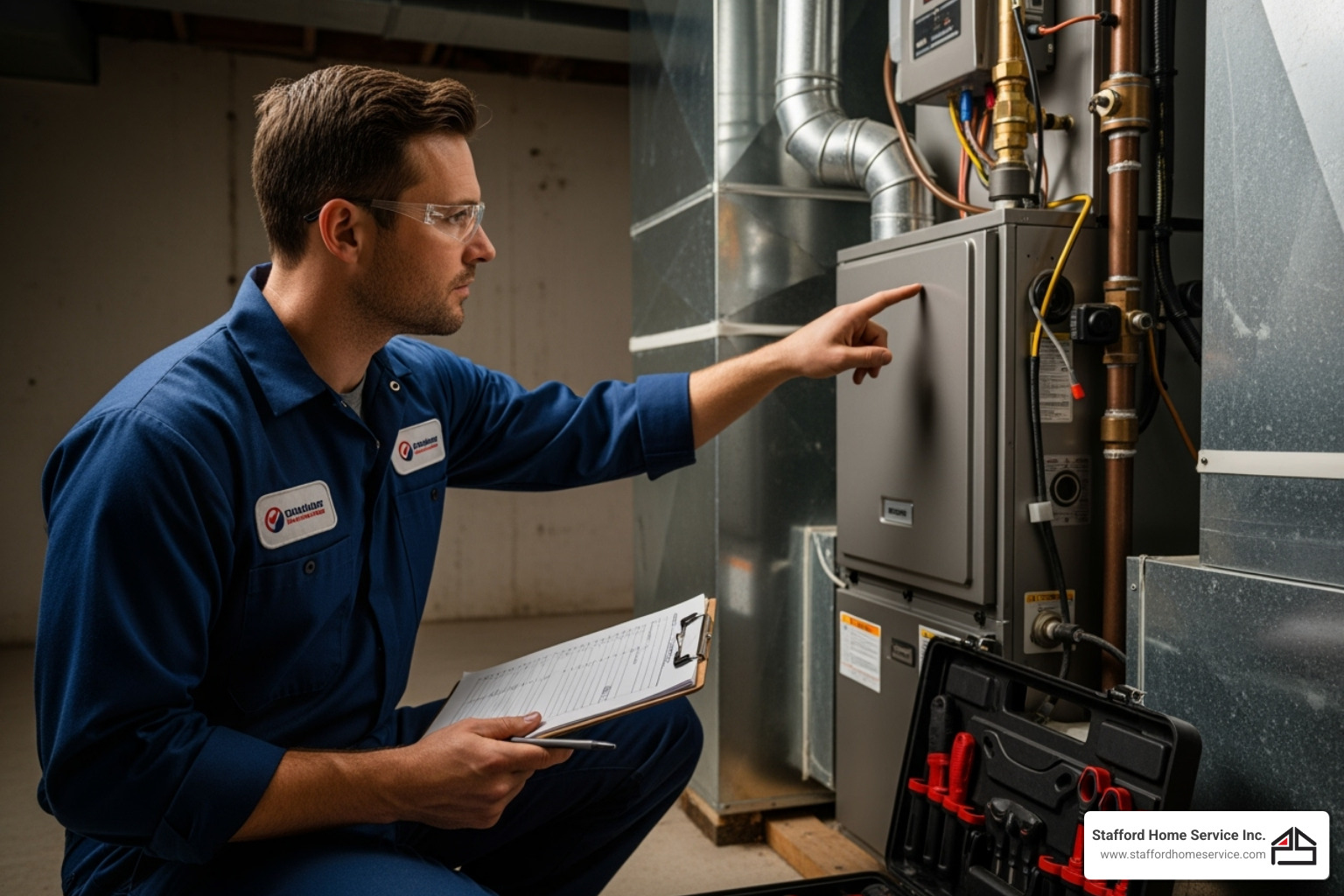
Living in Minnesota means we rely heavily on our furnaces, and naturally, that brings up plenty of furnace repair questions. Whether you’re wondering what happens during that annual service call or trying to figure out if you can handle a repair yourself, having clear answers helps you make smart decisions about keeping your home warm and comfortable.
What does a furnace checkup typically include?
Think of a furnace checkup as a comprehensive health exam for your heating system. When our technicians arrive at your home, they bring years of experience and a detailed checklist to ensure nothing gets overlooked.
The visit starts with a thorough inspection of all major components, including the heat exchanger, burner, and blower motor. Safety comes first, so we always test for gas and carbon monoxide leaks – this isn’t something to take chances with, especially in a tightly sealed home during winter.
Component cleaning is a crucial part of every checkup. Over time, dust and debris accumulate on critical parts like the burners and flame sensor. A dirty flame sensor, for instance, can cause your furnace to short cycle, turning on and off repeatedly without properly heating your home. We also focus on lubrication of moving parts to prevent that annoying squealing sound that often develops in blower motors.
Your comfort depends on accurate temperature control, so thermostat calibration ensures your system responds properly to your settings. We also perform an electrical connection check to catch any loose wires or signs of wear before they cause bigger problems.
During the inspection, we’ll examine your air filter and let you know if it needs replacing. A clogged filter forces your furnace to work harder and can lead to poor air quality throughout your home.
After completing the checkup, we’ll walk you through our findings in plain English. Sometimes everything looks great and you’re set for the season. Other times, we might recommend simple maintenance tasks or identify repairs that will prevent future breakdowns.
How often should I schedule furnace maintenance?
Here’s the honest truth – most of us don’t think about our furnaces until they stop working, usually on the coldest day of the year. But annual service is one of the best investments you can make in your home’s comfort and your wallet.
We recommend scheduling your pre-season checkup every fall, ideally in September or early October before you really need the heat. This timing gives us a chance to address any issues that developed over the summer and ensures your system is ready when temperatures drop.
Between professional visits, there’s one simple task that makes a huge difference: filter replacement. Most filters need changing every one to three months, depending on your home’s conditions. If you have pets, allergies, or run your system frequently, you’ll probably need to change filters monthly.
Regular maintenance doesn’t just prevent emergency breakdowns – it actually extends your furnace’s lifespan and keeps it running efficiently. A well-maintained furnace uses less energy, which shows up as savings on your heating bills month after month.
Can I fix furnace problems myself?
We love homeowners who want to understand their systems and handle basic maintenance. There are definitely some DIY tasks that are safe and straightforward for most people to tackle.
Checking your thermostat settings, replacing a dirty air filter, and making sure the power switch hasn’t been accidentally turned off are all things you can handle confidently. You can also check that your circuit breaker hasn’t tripped and ensure the furnace access panel is properly closed.
However, when it comes to gas and electrical systems, we strongly encourage you to call professionals. These complex components require specialized knowledge and tools to service safely. We’ve seen too many well-intentioned DIY attempts that created bigger problems or, worse, safety risks like gas leaks or carbon monoxide issues.
The rule of thumb is simple: if basic troubleshooting doesn’t solve the problem, or if you feel uncertain about any step, it’s time to call a professional. Our experienced technicians have the training to diagnose issues accurately and fix them right the first time, keeping your family safe and your home comfortable throughout the heating season.
Improving Furnace Efficiency and Performance
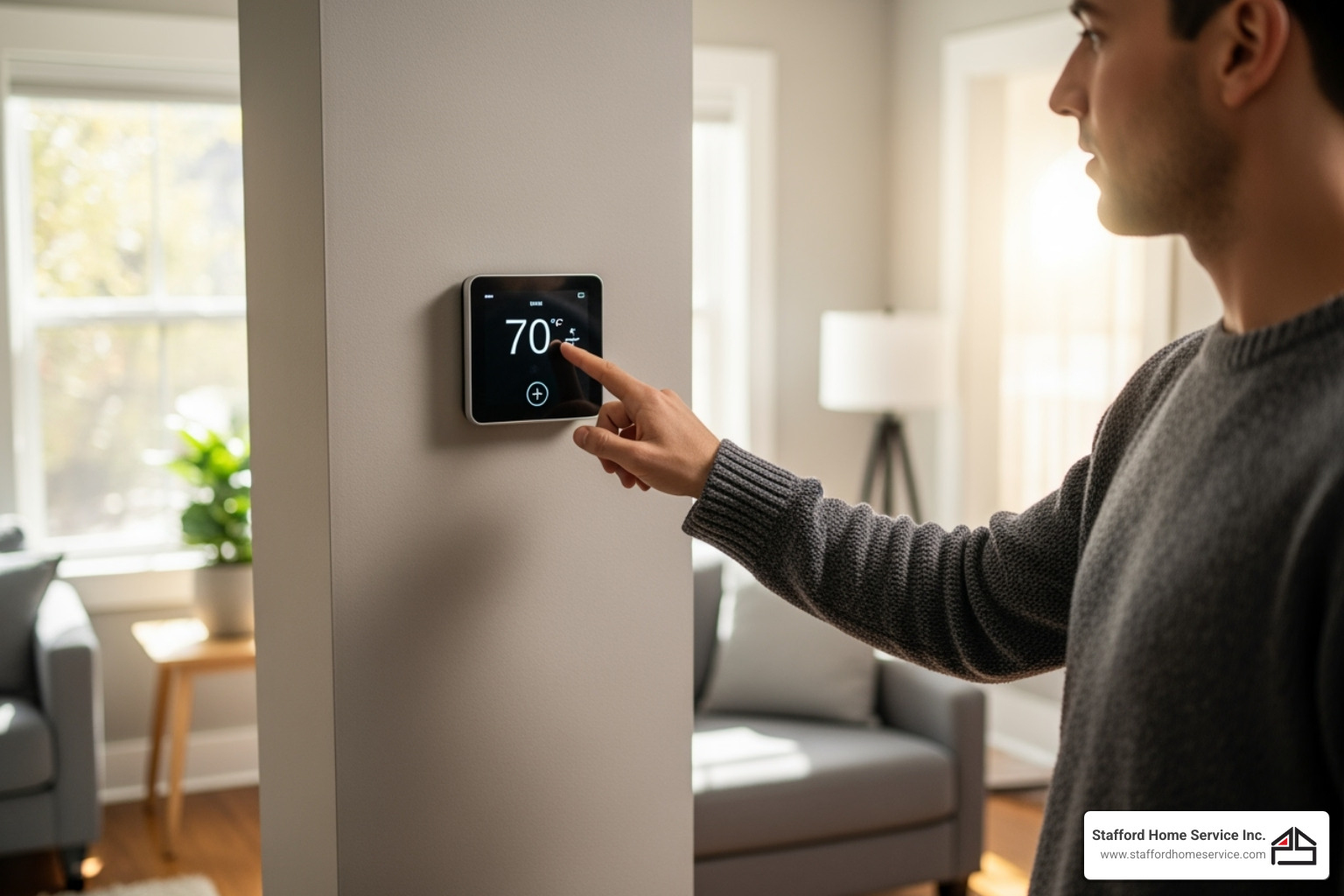
When it comes to keeping your home comfortable without breaking the bank, your furnace’s efficiency makes all the difference. Think of it this way: an inefficient furnace is like driving with the brakes on – it’s working harder than it needs to and costing you more money every month. The good news is that there are plenty of ways to help your heating system run smarter, not harder.
Many of the furnace repair questions we hear from homeowners center around performance issues that could be prevented with simple efficiency improvements. The best part? Some of these solutions are things you can tackle yourself, while others might surprise you with how much difference they make.
How can I improve my furnace’s efficiency?
The path to better furnace efficiency starts with understanding that small changes can lead to big savings. Since heating can account for up to 42 percent of your home’s utility bill, even modest improvements in efficiency can make a noticeable difference in your monthly expenses.
Regular filter changes remain the single most important step you can take. A dirty filter is like trying to breathe through a straw – your furnace has to work overtime to push air through that clogged barrier. Changing your filter every 1-3 months, especially during peak heating season, instantly improves both efficiency and air quality throughout your home.
Sealing air leaks around your home works hand in hand with your furnace’s efficiency. Even the most efficient heating system can’t overcome heat loss through drafty windows, doors, or poorly insulated areas. When you seal these leaks and insulate your ductwork, you’re essentially keeping all that expensive heated air where it belongs – inside your home.
Upgrading to a programmable or smart thermostat is one of those improvements that pays for itself over time. These devices automatically adjust temperatures based on your schedule, lowering the heat when you’re away or asleep. It’s like having a personal assistant for your heating system, making smart decisions even when you’re not thinking about it.
Don’t overlook the simple step of keeping your vents clear. Furniture, rugs, or curtains blocking your heating vents force your system to work harder to circulate air properly. It’s amazing how much difference this simple adjustment can make for both efficiency and comfort.
Understanding AFUE ratings helps you make informed decisions about your heating system. Older furnaces with continuous pilot lights typically operate at 56 to 70 percent efficiency, while newer high-efficiency models achieve 90 to 98 percent efficiency. If your furnace is getting older, this efficiency gap represents significant potential savings on your energy bills. You can learn more about current furnace efficiency standards from the Department of Energy.
What are the most common furnace repair questions about performance?
Performance problems often leave homeowners scratching their heads, wondering what’s going wrong with their heating system. These issues can be particularly frustrating because they don’t always mean your furnace is completely broken – just not working as well as it should.
Furnaces blowing cold air top the list of performance complaints we hear. Before panicking, check if your thermostat fan setting is on “ON” instead of “AUTO” – this simple setting causes the fan to run continuously, even when the furnace isn’t actively heating. Other causes include an overheating limit switch that shuts off the burners for safety, a clogged filter restricting proper airflow, or problems with the pilot light or ignition sensor.
Short cycling – when your furnace turns on and off too frequently – wastes energy and puts unnecessary stress on your system. This frustrating problem often stems from a dirty flame sensor that can’t properly detect the flame, an oversized furnace that heats your home too quickly, or a malfunctioning thermostat sending mixed signals.
Continuous running presents the opposite problem, where your furnace seems to never take a break. This usually indicates a faulty limit switch that isn’t properly shutting off the burners, or thermostat issues that keep calling for more heat even when your home has reached the desired temperature.
Weak airflow from your vents can make even a perfectly functioning furnace feel inadequate. This problem typically points to dirty ductwork that’s restricting air movement, a severely clogged air filter, or mechanical issues with the blower motor or fan components.
For older furnaces, pilot light problems remain a common concern. When the pilot light won’t stay lit, it’s often due to a dirty thermocouple, drafts affecting the flame, or a faulty gas valve that needs professional attention.
Thermostat malfunctions can create all sorts of performance headaches, from wildly inaccurate temperature readings to erratic cycling patterns, or even preventing your furnace from turning on at all. Since your thermostat is essentially the brain of your heating system, when it’s not working properly, nothing else can function as it should.
Addressing these performance issues quickly helps restore your furnace’s efficiency and keeps your home consistently comfortable throughout the heating season
Troubleshooting Common Furnace Issue

When your furnace decides to take an unexpected vacation right when you need it most, it’s natural to feel a wave of panic. But before you start envisioning frozen pipes and astronomical emergency repair bills, take a deep breath. Many common furnace repair questions can be resolved with some simple detective work that doesn’t require any special tools or technical expertise.
We’ve found that homeowners can often get their heating systems back up and running by checking a few basic things first. Think of it as giving your furnace a gentle nudge rather than major surgery – sometimes that’s all it takes to restore warmth to your home.
What should I do if my furnace won’t turn on?
A completely silent furnace can be one of the most stressful situations a homeowner faces, especially during a Minnesota winter. The good news is that many times, the solution is much simpler than you might expect. We recommend working through these steps systematically before calling for help.
Start with your thermostat settings – it might seem too obvious, but you’d be surprised how often this solves the problem. Make sure it’s actually set to “HEAT” rather than “COOL” or “OFF,” and verify that the temperature setting is higher than what the thermostat is currently reading in your home. If you have a digital thermostat that seems unresponsive, try replacing the batteries.
Next, head to your circuit breaker panel and look for the breaker labeled for your furnace or heating system. If it’s tripped, it will be sitting in a middle position between “ON” and “OFF.” Flip it completely to “OFF” first, then back to “ON.” Power surges or electrical hiccups can sometimes cause this, and it’s an easy fix.
Don’t forget to check the furnace power switch itself. Most furnaces have a simple on/off switch located on or near the unit that looks just like a regular light switch. It’s surprisingly common for this to get accidentally turned off during routine activities in the basement or utility room.
For gas furnaces, you’ll want to ensure the gas valve is open. Follow the gas line to your furnace and locate the shut-off valve. When the handle runs parallel to the pipe, the valve is open. If it’s perpendicular to the pipe, it’s closed and needs to be turned.
Finally, check that all access panel doors are securely closed. Modern furnaces have safety switches that prevent operation if panels aren’t properly in place. Even a slightly loose panel can trigger this safety feature.
If you’ve methodically gone through each of these steps and your furnace is still giving you the cold shoulder, it’s time to call in professional help.
Why is my furnace blowing cold air?
Few things are more confusing than a furnace that seems to be working – you can hear it running – but is sending chilly air through your vents instead of the warm comfort you’re expecting. This particular issue generates quite a few furnace repair questions from homeowners, and fortunately, some causes are easier to fix than others.
The most common culprit is your thermostat fan setting. When your thermostat fan is set to “ON” instead of “AUTO,” it runs continuously, even when your furnace isn’t actively heating. This means you’ll get warm air when the burners are firing, but cold air when they’re not. Switching to “AUTO” ensures the fan only circulates air when it’s actually been heated.
Sometimes your furnace’s overheating limit switch is doing exactly what it’s designed to do – protecting your system. When airflow becomes restricted (often due to a severely clogged filter), your furnace can overheat. The limit switch then shuts off the burners as a safety measure, but the fan continues running to cool things down, pushing unheated air through your ducts.
A clogged air filter deserves special attention because it’s both a common cause and an easy fix. When a filter becomes completely saturated with dust and debris, it creates a domino effect – restricted airflow leads to overheating, which triggers safety switches, which results in cold air circulation.
For gas furnaces, issues with the pilot light or ignition sensor can prevent the burners from lighting at all. You might hear the furnace trying to start, but without successful ignition, there’s no heat to distribute. The fan will still do its job of moving air, just not the warm air you want.
High-efficiency furnaces can develop condensate line clogs that trigger safety switches. These systems produce water as they operate, and when the drainage system backs up, built-in safety features shut down heat production while the fan continues running.
If these troubleshooting steps don’t restore your warm, cozy home, our experienced team is ready to help diagnose and resolve the issue quickly, serving homeowners throughout Minneapolis, Edina, Golden Valley, Minnetonka, Plymouth, and St. Louis Park.
Conclusion
We know that dealing with furnace repair questions can feel overwhelming, especially when you’re facing a chilly night and your heating system isn’t cooperating. Throughout this guide, we’ve walked through the warning signs that signal trouble, the basics of maintenance schedules, and those frustrating moments when your furnace decides to blow cold air instead of keeping you cozy.
The truth is, most furnace issues don’t happen overnight. They give us hints – strange noises, uneven heating, or that gradual creep upward in energy bills. By staying alert to these signs and understanding what they mean, you’re already ahead of the game. Regular maintenance isn’t just about fixing what’s broken; it’s about catching small issues before they turn into expensive emergencies that leave you bundled up in blankets.
At Stafford Home Service Inc., we’ve built our reputation on quality workmanship, complete customer satisfaction, and experienced owners who truly understand what it means to keep Minneapolis-area homes comfortable year-round. We stand behind every job with our Daikin Comfort Promise and offer flexible financing options because we believe everyone deserves reliable heating, regardless of their budget situation.
Whether you’re hearing mysterious rattling sounds, dealing with rooms that never seem to warm up, or facing a complete system shutdown, our certified technicians have seen it all. We serve homeowners throughout Minneapolis, Edina, Golden Valley, Minnetonka, Plymouth, and St. Louis Park with the same commitment to excellence and honest service that has made us a trusted name in the community.
Don’t let furnace repair questions keep you awake at night wondering if that strange noise means trouble. Taking action early – whether it’s scheduling annual maintenance or addressing performance issues as they arise – leads to better efficiency, lower energy bills, and the peace of mind that comes with knowing your family will stay warm all winter long.
Ready to get your heating system back on track? Schedule your furnace repair in Minneapolis with our team today, and let us help you enjoy reliable, comfortable heating throughout the season.=
Customer Testimonials
Our customers consistently praise our knowledgeable technicians, prompt service, and the lasting quality of the work we deliver.
ABOUT STAFFORD HOME SERVICE
In 2007, long-time team members Kris Thompson and Dan Fournier took ownership of Stafford Home Service. With over 60 years of combined expertise in residential electrical and HVAC, they continue the legacy of former owners Curt Cervin and Paul Stafford—delivering quality workmanship and complete customer satisfaction.
70+ Years
Family-operated experience delivering trusted electrical, heating, and cooling services.
800+
Verified 5-star reviews from satisfied customers.
